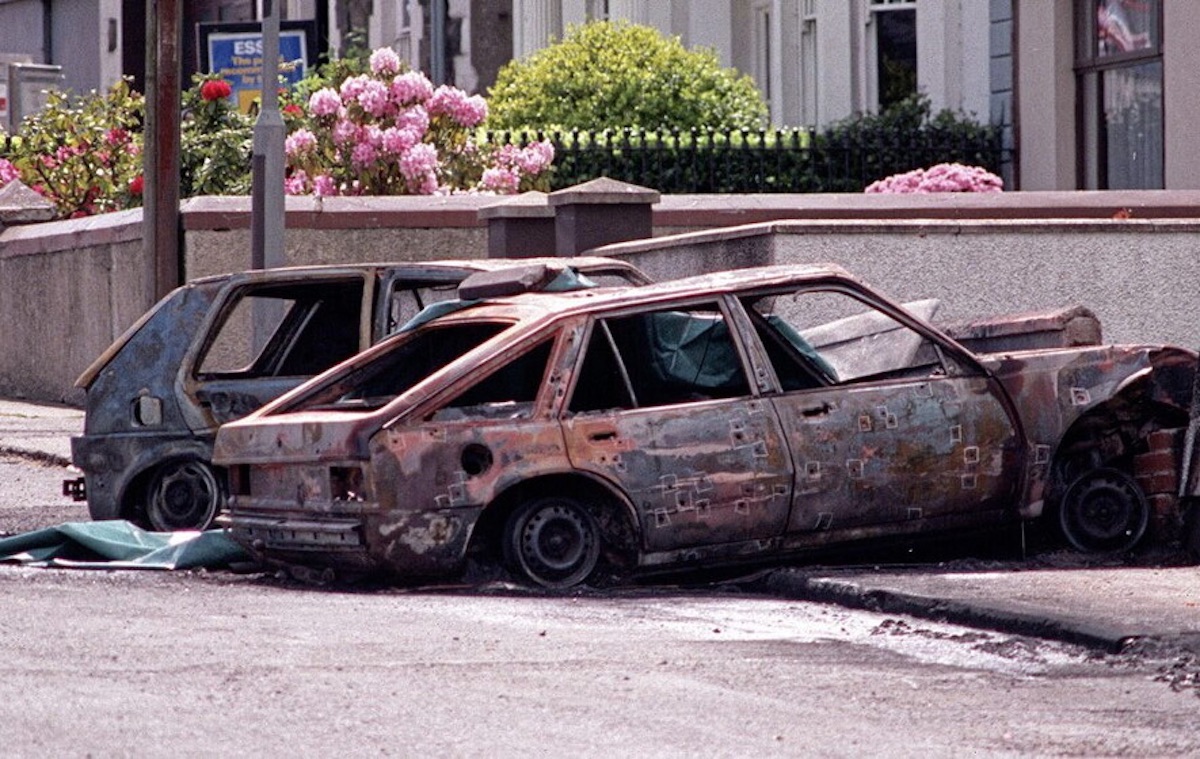
A former senior member of the RUC has revealed he was instructed not to question British soldiers about the planning of an infamous shoot-to-kill ambush which resulted in the killing of three IRA Volunteers in County Tyrone.
IRA Vols. Pete Ryan, Lawrence McNally and Tony Doris were shot dead in the village of Coagh in June 1991 in an operation believed to have been carried out by the ‘elite’ British Army unit, the SAS.
The three IRA men were driving in a car when the ambush was launched, riddling the vehicle with bullets before it crashed. Two of the men attempted to escape but were gunned down. The bodies of the three victims were burnt beyond recognition and later identified only by dental records.
At an inquest into the ambush in Banbridge last week, retired senior RUC policeman George Samuel Christy, who supposedly investigated the killings, revealed how he was instructed not to quiz British soldiers on how the operation was planned.
Under questioning from Karen Quinlivan, Mr Christy confirmed that a similar instruction was issued in relation to other cases. When pressed on where the direction had come from, Mr Christy referred to the Chief and Special Branch of the RUC (now PSNI), but provided no other details.
In an exchange on the lack of a subsequent investigation, the former RUC detective superintendent agreed that “one of the allegations might be that there was an agreement or plan in advance to kill these IRA operatives”.
“You will have realised that was an issue,” the coroner said.
“But the evidence you have given me today is that you weren’t allowed to go there, you were not allowed by a Special Branch officer, or possibly the chief constable, but you were directed not to investigate whether there in fact was a plan to kill these people,” he said.
In reply, Christy said: “That’s correct my lord.”
The coroner continued: “So that was an obvious area that wasn’t under consideration in your investigation, you simply didn’t look at that issue”.
“That’s correct,” Christy replied.
The retired RUC man also agreed with the coroner that if he had “established there was an agreement to kill these people, or whoever might have attended at the scene in Coagh, then that would have been a conspiracy to murder potentially”.
Mr Christy also agreed with the coroner that in his correspondence with the Crown Prosecutors he failed to mention that he had not investigated the “planning or conception” of the attack.
He later said he was “instructed to take it from the scene of the shooting and so on and investigate that. Not to go back any further than that,” he said.
The coroner said: “But that’s not an instruction that would be given to you in relation to any ordinary crime, nobody would say to you, don’t investigate how it came to pass that this incident happened.
“Just investigate the incident. This only happened presumably to you when there was lethal force used by the army.”
Mr Christy replied “it did in this incident my lord, yes” and agreed that it also happened in other instances.
During the hearing the coroner raised the Stalker Inquiry, which investigated suspicions of a shoot-to-kill policy, and the 1987 Loughgall ambush, during which nine people, including eight IRA Volunteers, were shot dead by the SAS.
“Because at this time reports from the Stalker Inquiry were in existence, senior members of the RUC would have been aware of things like Stalker, Loughgall had happened and there had been other incidents at which (a) shoot-to-kill policy had been alleged.
“And you were specifically directed not to investigate whether that had happened in this particular case?” the coroner asked.
“That’s what I was told my lord,” the former RUC man replied.
It is not known which other cases were being referred to, but during the late 1980s and 1990s a Crown Force killing spree carried out across the north resulted in a significant loss of life which has never been fully investigated. Dozens of sectarian murders were also carried out by loyalist gangs, most of which were directed or motivated by the RUC and British army.
Pádraig Ó Muirigh, of Ó Muirigh lawyers, who represents the Ryan and Doris families, said the evidence of Mr Christy “in relation to the role of Special Branch in curtailing the RUC investigation of these deaths was very significant”.
“It has been the long held view of the families that I represent that there was no attempt by the RUC to investigate the actions of the British soldiers,” he said.
![[Irish Republican News]](https://republican-news.org/graphics/title_gifs/rn.gif)
![[Irish Republican News]](https://republican-news.org/graphics/title_gifs/harp.gif)

